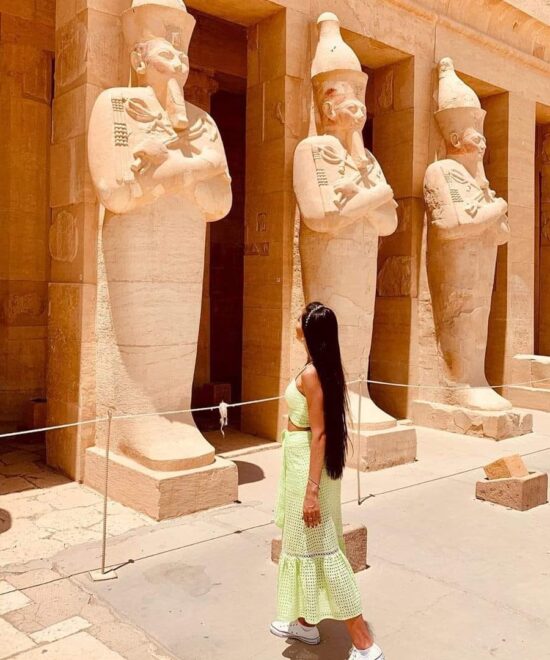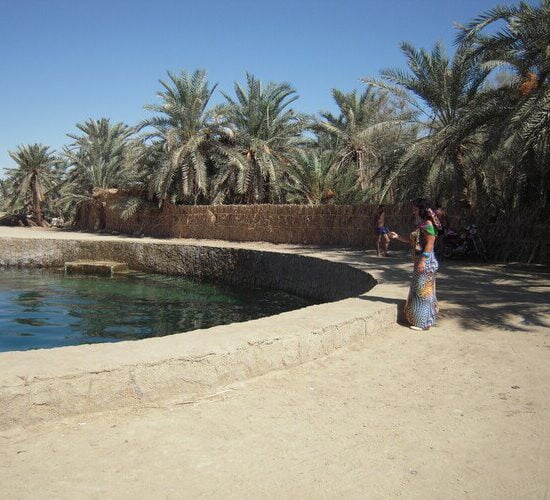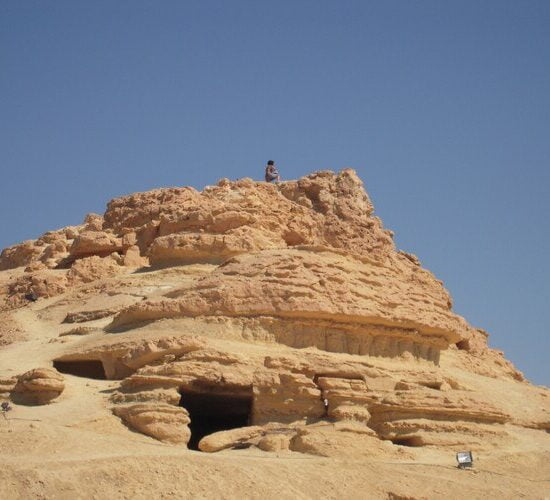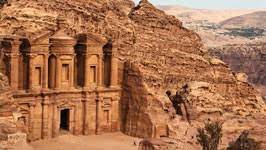


14 Days Tour “Through the Western Desert via Gilf Kebir”, Tour II
Explore Tours
Day 1: Cairo – Bahariya Oasis
Early in the morning, our representative will meet you at your hotel in Cairo to embark on an exciting journey through the Bahariya Oasis. If you are staying in a hotel in another city in Egypt, such as Luxor or on the Red Sea coast, we can arrange a transfer to Cairo or directly to the oasis.
After breakfast at the hotel, you will take a jeep to Bahariya Oasis, the largest and most important oasis of the Western Desert. When you visit the town of Bawiti, you will see how the main crops (guava, mango, dates, olives) are grown, as well as some of the historical attractions of the city. The Greco-Roman necropolis, also known as the Valley of the Golden Mummies, contains a huge number of mummies. In the museum, surprise some mummies as well as sarcophagi painted with gold paint. Next, you will visit the remains of Ain Tibnya, the temple, clock of the reign of Alexander the Great, who is said to have passed through this oasis; the tomb of Banentiou, with its well-preserved coloured hieroglyphs and paintings; a temple in the Ain Muftella area with four chapels, the walls of which are about two meters high and built about 2600 years ago. Lunch awaits you in one of the local restaurants. The rest of the day is completely at your disposal and you can relax at the hotel or go for a walk. Dinner at the hotel.
Breakfast, lunch and dinner are included. Overnight at the hotel in Bahariya.
Day 2: Bahariya Oasis – Dakhla Oasis
After breakfast at the hotel, you will drive to Dakhla Oasis, a huge green area surrounded by pink cliffs. Visit Al Qasr, an old Islamic fortified settlement with well-preserved various buildings (dwellings, mosques, mills, madrasahs, and artisans’ workshops). Dinner will be served at the hotel where you will spend the night.
Breakfast, lunch and dinner are included. Overnight at the hotel in Dakhla Oasis.
3rd day: Abu Ballas – Clay Lions
After an early breakfast, you will take a jeep ride through the desert to the south. You will visit the high lonely hill of Abu Ballas, which translates from Arabic as “Father of Pots”, on which a large number of pottery was found, which once served as a kind of water storage for caravans. They are more than 3500 years old. Just above the hill you will find some prehistoric petroglyphs (cave paintings). After about an hour’s drive, You will see another geological formation, these are quite specific groups of low hills that look like stacked lions. They are called clay lions (or red lions). The rows of these hills have a clear direction corresponding to the prevailing winds. This is where you will set up a campsite, where you will have dinner and spend the night in a tent or under the open starry desert sky.
Breakfast, lunch and dinner are included. Overnight at the campsite.
Day 4: Eight Bells – Prince Kamal El-Din Monument – Gilf Kebir
After breakfast, you will head to the famous attraction “Eight Bells“. It is an old British military airport from the beginning of World War II, which is located on a sandy plain surrounded by eight bell-like hills, which is the name of this place. Further on, you will see the monument of Prince Kamal El-Din, a simple stone pyramid built in honor of the great explorer of the deserts. And finally, the rocky plateau of Gilf Kebir, one of the most beautiful places in Egypt, the size of the state of Puerto Rico. There are not only beautiful desert landscapes and rocks, but also numerous engravings and colorful pictographs that testify to the residence of people here more than 10 thousand years ago.
Breakfast, lunch and dinner are included. Overnight at the campsite.
Day 5: Wadi Wasa – Wadi Farakh – Mogharat El Kantara Cave (Shaw Cave)
You will cross Wadi Vasa, a large gorge flanked by valleys and small hills. In Wadi Farakh you will see rock paintings in the Moghharat el Kantara cave, also known as the Shaw Cave; the animal and the hunters are depicted in different colors.
Breakfast, lunch and dinner are included. Overnight at the campsite.
6th day: Wadi Sura – Swimmers’ Cave – New Cave
Today you will see the most popular places in Gilf Kebir – Wadi Sura, a valley that passes through a steep cliff of 300 meters. Here is the famous Swimmers’ Cave with its stunning rock carvings of swimming people from the prehistoric period, testifying to the fact that there was no desert at all in those days. There are also images of moving people as well as a variety of animals. A few kilometers away there is another example of ancient A new cave discovered in 2002. It is one of the most important prehistoric sites in the Eastern Sahara, as it contains numerous ochre mosaics. You will see countless silhouettes of human hands, pictures of people in different dynamic poses and different activities such as hunting, dancing, playing or holding hands with their children…
Breakfast, lunch and dinner are included. Overnight at the campsite.
7th day: Aqaba Pass – Gilf Kebir Plateau
Today you will walk through the Aqaba Pass to reach the upper plateau. This rather grueling but quite exciting adventure you should not miss. You’ll explore Gilf Kebir from above and take a tour not across a flat plain; A mesmerizing and breathtaking landscape from the mountain will open up before you. You’ll also pass by the Lama Monument, is a memorial site dedicated to the desert explorer Samir Lama, which is located on one of the most beautiful places on the plateau.
Breakfast, lunch and dinner are included. Overnight at the campsite.
Days 8-12: Wadi Hamra – Silicon Valley – Great Sand Sea – Ain Della Oasis
You will start your descent from Gilf Kebir and first of all pass through Wadi Hamra, a very beautiful route, as the black slopes are covered with red sand and there are interesting examples of rock art in addition to acacias. Then you will cross the great expanse of the Great Sand Sea with its dunes. You will also visit the Quartz Valley – a huge field of yellow-green shards. This beautiful material is also known as “Libyan glass” or “desert emeralds”. Most likely, this is the result of an asteroid that collapsed here and this is the only place on Earth with such rocks. Even the mineral that shines in the center of Tutankhamun’s famous necklace, formed when a huge meteorite hits the ground, is similar in structure to these yellow-green fragments. Finally, you will reach the small oasis of Ain Della. This is the westernmost oasis for those who were going to cross the desert – and take a tour through the White Desert.
Breakfast, lunch and dinner are included. Overnight at the campsite.
Day 13: White Desert – Bahariya Oasis
After breakfast, you will set off to explore the White Desert National Park. This desert was once the bottom of the ocean, but after the water receded, there were cross formations that formed bizarre landscapes of amazing beauty. Enjoy this unique landscape, the famous Crystal Mountain and the picturesque Agabat Valley, After all, you won’t find anything like it anywhere else. Lunch will be served as a small picnic. In the evening you will arrive at Bahariya Oasis where you will have dinner and spend the night at the hotel.
Breakfast, lunch and dinner are included. Overnight at the hotel in Bahariya.
Day 14: Bahariya Oasis – Black Desert – Cairo
Early in the morning, you will take a jeep to the Black Desert, where you will see numerous rocks and hills covered with black basalt. Then you will have lunch, after which you will drive to Cairo to your hotel. This concludes our excursion program.
Breakfast and lunch are included.
Included/Exclude
- Pick-up and drop-off at the hotel, as well as transfer between the locations indicated for the visit, in a comfortable air-conditioned vehicle
- Guide services
- Entrance fees to all designated places to visit
- Half-board hotel accommodation in oases
- Camping in the desert
- Meals, mineral water and soft drinks during excursions and tours
- Tips for drivers, guides
- Extras: personal items, meals, drinks
Tour Plan
Related Tours
Review Scores
Booking Tour






